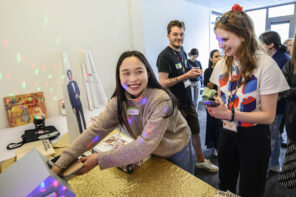Over the last ten years, curatorial innovations and digital resources have radically transformed public engagement with moving image archive, giving new life to film collections. At DCA Dundee for This Way Up 2022, a panel spoke about how young audiences are discovering film heritage in a whole new light – Camilla Baier writes for The Bigger Picture about what was discussed.
‘In 20 years, TikTok will be considered an archive’, says Isra Al Kassi, founder of T A P E collective and host of the Opening Up the Archive panel on the second morning of this year’s This Way Up conference. The audience of exhibitors (possibly even Tik-Tokers) in DCA’s Cinema One chuckle nervously as she lets this provocation sink in for her panel of archive specialists – Rose Baker (Belfast Film Festival), Andy Robson (Film Hub North) and Lauren Clarke (Invisible Women).
This was not the opening statement of the session, but here is how we got there;
In the spirit of demystifying the archive through a discussion of how curatorial innovations and digital resources have radically transformed public engagement with moving image archives, Isra kicked off by asking the panel how they would define the archives that they work with and/or promote and encouraged them to share how they use these in their practice.
Rose Baker, who programmes the UK and Ireland section of the Belfast Film Festival, spoke of her most recent success story. For Vox Populi: The Voice of the People, an installation staged in a much loved but little accessed historic building in the centre of Belfast, Baker sourced news footage from the regional UTV archive collection, part of the Northern Ireland Screen Digital Film Archive. “The people of Belfast just want to go into old buildings” says Rose. Using this curiosity to introduce new audiences to their screen heritage proved to be the perfect pairing.
Shifting focus
Curiosity is a neat segue here, as next up was Andy Robson, outlining the aims of the Changing Times: CURIOUS Heritage Programme Engagement Fund. This UK-wide project supported exhibitors in organising especially curated events using material from 13 national and regional film archives, encouraging the use of specialist and independent archives to complement these regional archives.
Invisible Women’s Lauren Clarke built on this by stressing the importance of shifting the focus of institutional archives to include include unofficial, volunteer-run or outsider collections such as archives such as Cinenova, a volunteer-run charity preserving and distributing the work of feminist film and video makers. Lauren also highlighted the value of engaging with filmmakers’ personal archives or estates, which the Invisible Women often uses in their mission to champion work made by women and marginalised gender filmmakers.
A discussion of the challenges of working with archive material has all three panelists agreeing that curating programmes from the archive is more time consuming and logistically demanding than contemporary film, particularly when you factor in the additional financial implications of having to pay for the digitisation of previously inaccessible analogue material.
Hearteningly the audience was not discouraged by this – in fact the first question to come from the audience – “how can one collaborate with practitoners working in and with the archive?” – suggested an eagerness to engage directly with this challenging but rewarding terrain. A consensus between the panellists again; reach out to the archivists/researchers/custodians of the archive that you are interested in, they can point you in the right direction of the material, but also of other exhibitors working in this area.
Understanding original context
Another audience question asked how to balance reimaging archive material with making sure audiences understand the original context of the work. Here Lauren stressed that we can only understand out present through looking at our past. For this reason, Invisible Women programmes are always accompanied by contextualisationthrough extensive research into the socio historical context of the films that they are showing. The panellists agree that context is key.
What they did not seem to completely agree on is what their cut off date for the term ‘archive’ for the moving image is; possibly any recorded material that is older than 10 years, possibly whatever is on a technological format that is no longer in mainstream use, like VHS?
Isra points out that how we understand the archive is ever evolving, but also cultural. In countries that don’t have a bricks-and-mortar film archive, YouTube is already the main moving image archive.
As archives move from these physical organisations and buildings to a more democratised and digital format, with open access to all and the opportunity for everyone to use the materials to produce their own programmes, the 20 year deadline for the archive of TikTok is slowly starting to look like an over-estimate.






